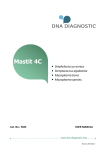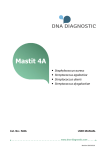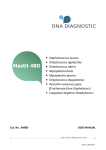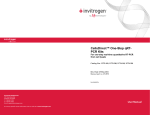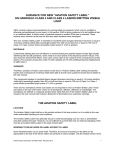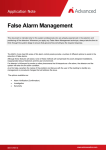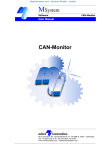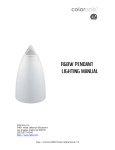Download Instruction Protocol M4A ()
Transcript
• • • • Cat. No.: M4A Staphylococcus aureus Streptococcus agalactiae Streptococcus uberis Streptococcus dysgalactiae USER MANUAL Revision 2015.08.15 TABLE OF CONTENTS 1. PRINCIPLE OF THE TEST ............................................................................................................................. 3 2. KIT COMPONENTS AND STORAGE ............................................................................................................. 3 3. REQUIRED EQUIPMENT ............................................................................................................................. 4 4. PROTOCOL ................................................................................................................................................. 4 5. INTERPRETATION OF TEST RESULTS .......................................................................................................... 6 Trademarks: Cy5 is a registered trade mark of GE Healthcare. Mx3005P, Stratagene and Agilent are registered trademarks of Agilent Technologies, Inc. Black Hole Quencher® (BHQ®), CAL Fluoor® and Quasar® dye technology incorporated in this product are used under licensing agreement with Biosearch Technologies, Inc. and protected by U.S. and world-wide patents issued or in application. 2 1. PRINCIPLE OF THE TEST The Mastit 4 test with Cat. No. M4A can be used for screening of 384 milk samples for four bacteria species: Staphylococcus aureus Streptococcus agalactiae Streptococcus uberis Streptococcus dysgalactiae Mastit 4 is the name of a family of fast, sensitive, and easy to use tests for detection of four mastitis causing bacteria species in one qPCR reaction. Mastit 4 testing involves an easy-to-do DNA extraction from 0.5 mL milk samples followed by a fast qPCR reaction. Test results can be acquired in 3 hours with very little hands on time. The Mastit 4 tests can be used on bulk tank milk or individual milk samples. The samples can be preserved or non-preserved. The qPCR test use approximately 1/6 of the purified DNA as template. The remaining DNA can be used for testing with other Mastit 4 variants or stored at -20oC for later use. The qPCR reaction contains four sets of primers and fluorescence probes for specific detection of four bacteria. A fifth set of primers and probe detects an internal amplification control (IAC). The qPCR instrument generates an amplification plot and Ct-values (Cycle at threshold). Each of the four bacteria probes emit a specific light (color) enabling the identification of bacteria present in the sample. The tests use the standard 96 well plate format and ready-to-use reaction mixes. The test requires only pipettes, a vacuum aspirator, a centrifuge, a thermal heating block and a qPCR instrument. 2. KIT COMPONENTS AND STORAGE The Mastit 4A kit contains material for testing 4x96 samples. One kit contains two boxes, one for storage at room temperature and one for storage at -20oC. Box for storage at room temperature contains: • Four sealed Deep Well Plates each with 96 wells containing a solution. • Four bottles with Wash Buffer, 100 mL each. • Four 96 Well Plates (0.2 mL clear tubes) with caps. • 12 pieces of sealing tapes for Deep Well plates. • Four 96 cap mats for the qPCR 96 Well Plates. Box for storage at -20oC contains: • Two bottles with Lysis Buffer-I, 5400 uL each. • Two yellow capped tubes with Mix I Additive for Lysis Buffer-I, 600 µL each. • Four sealed 96 Well Plates (0.2 mL white tubes) with qPCR Master Mix. 3 3. REQUIRED EQUIPMENT • Centrifuge for 96 well plates, centrifuge must be capable of running at 5000xg at 37oC • Pipettes and sterile filter tips • Incubation oven at 37°C • Plate washer / vacuum system to aspirate supernatant from Deep Well Plates (Biorad DW40 can be used) • PCR instrument for 37°C and 95°C incubations during lysis. Alternatively, the qPCR machine can be used. • qPCR instrument, Stratagene Mx3005 with filters for ATTO (440nm-492nm), FAM (492nm516nm), HEX (535nm-555nm), ROX (585nm-610nm), CY5 (635nm-665nm). 4. PROTOCOL DNA purification 1. Spin a 96 Deep Well Plate 1 min at 1000 g and remove seal. Add 0.5 ml milk sample to each of the wells. Cover wells with sealing tape. 2. Incubate the Deep Well Plate at 37°C for 10 min. 3. Spin Deep Well Plate with milk at 37°C and 5000xg for 5 min. and discard sealing tape. Remove supernatants from the top with tips connected to a vacuum system. Be careful not to touch or remove the bacterial pellets. 4. Add 1 mL Wash Buffer to each tube. Cover with sealing tape. 5. Spin at 5000xg and at 37°C for 5 min. and discard sealing tape. Remove supernatants from the top with tips connected to a vacuum system. Be careful not to touch or remove the bacterial pellets. It is important to remove the supernatant completely. 6. Prepare fresh Lysis-I Mix by adding 3 µL Mix I additive to 27 µL Lysis buffer-I and mix. Lysis-I Mix 1 reaction 100 reactions Lysis Buffer-I 27 µL 2700 µL Mix I additive 3 µL 300 µL TOTAL 30 µL 3000 µL 4 7. Add 30 µL Lysis-I Mix, to each pellet and cover with sealing tape. Vortex the Deep Well plate 10 seconds and spin 20 seconds at 1000xg to bring Lysis mix to the tube bottoms. 8. Remove caps from 96 well plate with clear 0.2 mL tubes. 9. Use an 8-channel pipette with filter tips for transfer of 30 µL from each well of the Deep Well Plate into the corresponding tubes in the 96 well plate (clear 0.2 mL). Close tubes with the caps. Avoid cross contamination. Use one new tip per tube. 10. Incubate the 96 well plate at 37°C for 20 min. 11. Incubate the 96 well plate at 95°C for 15 min. 12. Cool the 96 well plate on ice for 5 min Note: The incubation at 37°C and 95°C can be done using a PCR instrument programmed: 37°C for 20 min. → 95°C for 15 min. → 4°C for 5 min. 13. Centrifuge the 96 well plate at 5000xg for 5 min. at room temperature. Note it is important to use a 96 tube support for the 96 well plate during centrifugation. 14. Carefully remove the caps from the 96 well plate. Use an 8-channel pipette with filter tips to transfer 5 µL of each aqueous phase directly to the corresponding tubes of the 96 well plate with qPCR Master Mix in step 18. 15. The remaining purified DNA can be stored at -20°C for long time storage. qPCR analysis 16. Take a 96 Well Plate with qPCR Master Mix (white 0.2 mL tubes) from -20°C, place on ice for five minutes and spin 20 seconds at 1000xg to bring qPCR Master Mix to the tube bottoms. 17. Discard the seal from the 96 Well Plate with qPCR Master Mix and place the 96 well plate on ice. 18. Transfer 5 µL purified DNA from step 14 to each of the corresponding tubes in the 96 well plate containing 15 µL qPCR Master Mix. Note: It is important to keep Master Mix on ice while loading template and to run the qPCR within 15 min. 19. Carefully close the qPCR tubes with a new optical lid. Spin the tubes briefly before transfer of the 96 Well Plate qPCR reactions to the qPCR instrument. Note it is important to keep the optical lids clean. Instrument settings for the MX3005P 20. Filter Gain Settings: ATTO FAM HEX ROX CY5 1x 2x 1x 1x 1x 5 Note: If the raw data signal (R) is lower than 5000 for a color at the cycles 7-11 then increase the filter gain setting during the next runs resulting in a raw data signal (R) of 5000-35000. 21. Threshold Fluorescence. Select “Background Based Threshold” to cycles 7-11 and set the “Sigma multiplier” to 10. 22. Baseline Correction. Select “Adaptive baseline”. 23. Activate the following filters: ATTO, FAM, HEX, ROX, CY5. 24. Run qPCR with the following cycling parameters: Temperature Time Cycles Comment 95°C 1 min. 1 Heat activation 95°C 5 sec. Amplification 40 60°C 25 sec.* * Read fluorescence for for ATTO, FAM, HEX, ROX, CY5 at the end of each extension step. 5. INTERPRETATION OF TEST RESULTS Generate amplification plots showing: • Thermal cycles on the X-axis. • Background subtracted fluorescence (dR) on the Y-axis. • Ct values are calculated automatically by the instrument. The Stratagene MxPro software should be set to Adaptive Baseline Correction and Background-based Threshold using cycle 7-11 and a sigma multiplier of 10. • Samples with Ct values below 37 and S-shaped amplification curves are considered as true positive. • Samples with Ct values above 37 may be a result of unspecific amplification (false positive). The test should be consider negative. • An IAC amplification signal in the ATTO filter should be present in all reactions. The IAC Ct-value must be between 27 and 32 for the test to be valid. Ct above 32 is only accepted when the reaction is highly positive (low Ct-value) for one of the bacteria in the test. 6 INTERPRETATION TABLE Filter Positive Negative Retest Ct Ct Ct Streptococcus uberis CY5 ≤37 None or >37 Streptococcus agalactiae ROX ≤37 None or >37 Streptococcus dysgalactiae FAM ≤37 None or >37 Staphylococcus aureus HEX ≤37 None or >37 ATTO 27-32 IAC >32 or absent If the IAC Ct is >32 or absent, the purified DNA should be diluted 10 times and a new qPCR reaction should be analyzed using this diluted DNA. A dilution of 10 times will theoretical move Ct values 3.3 higher than undiluted. dR 20.000 - 10.000 - Ct Threshold line 00 10 20 30 40 Cycles Amplification plot with X-axis showing cycle number and Y-axis showing background subtracted fluorescence. The threshold line is used to find the Ct value. Ct is the intersection between the amplification curve and the threshold line. The threshold line is calculated automatically by the instrument giving in this example a Ct value of 24.4 7 Four examples of amplification plots each positive for one bacteria species and the IAC S. dysgalactiae (FAM), IAC (ATTO) S. agalactiae (ROX), IAC (ATTO) 8 S. aureus (HEX), IAC (ATTO) S. uberis (CY5), IAC (ATTO) 9 • • • • Staphylococcus aureus Streptococcus agalactiae Streptococcus uberis Streptococcus dysgalactiae For more information, contact DNA Diagnostic A/S Voldbjergvej 16 8240 Risskov Denmark Tel.: +45 8732 3050 E-mail: [email protected] www.dna-diagnostic.com DNA Diagnostic A/S was established in 1992. DNA Diagnostic A/S is an ISO 9001 and ISO 13485 certified developer, manufacturer, and worldwide supplier of PCR based in vitro diagnostic kits. Cat. No.: M4A USER MANUAL 10










